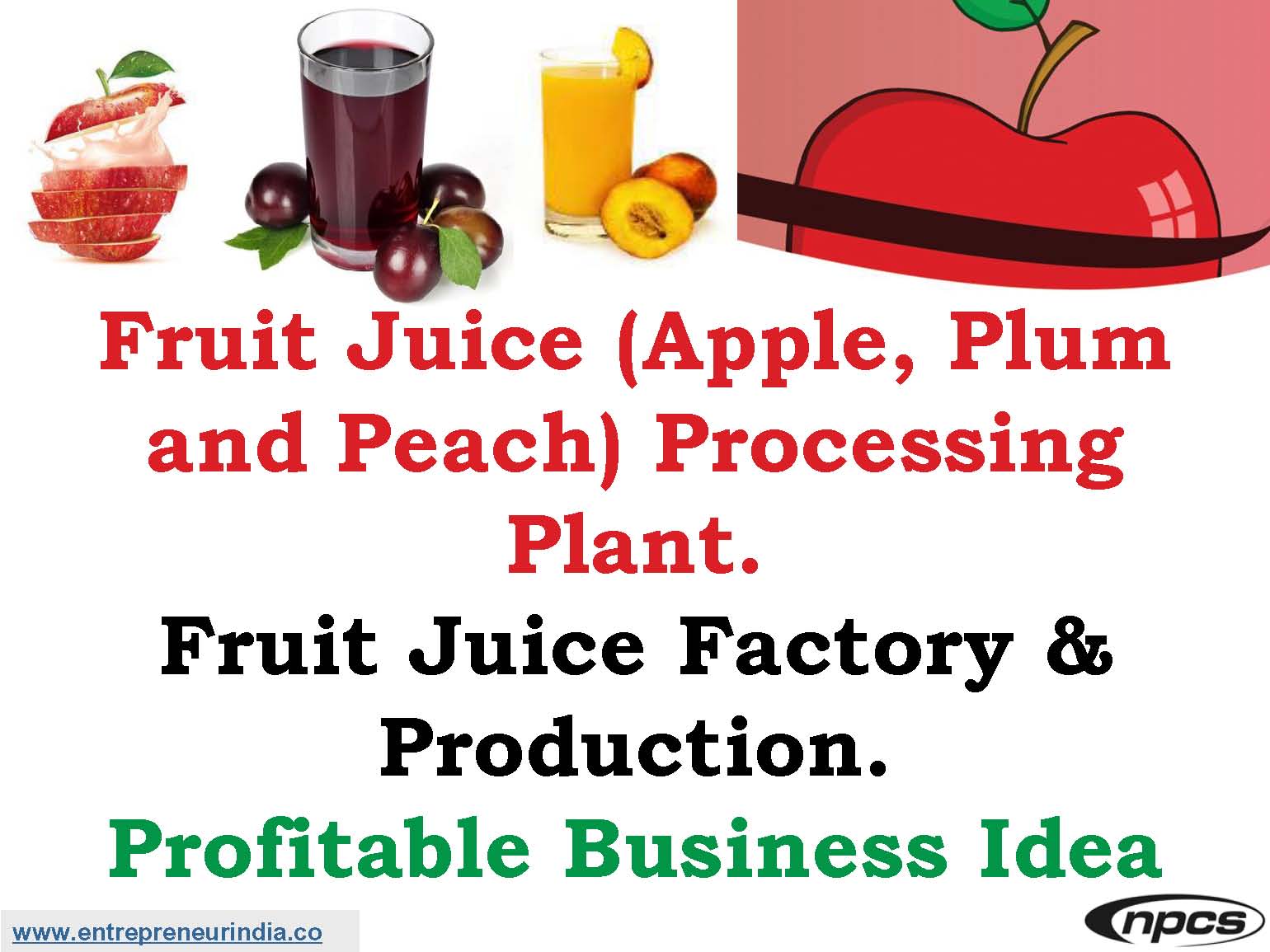
With rising health awareness and increasing demand for natural beverages, investing in a Fruit Juice (Apple, Plum and Peach) Processing Plant is becoming one of the most promising business ventures. Fresh fruit juices are preferred over carbonated drinks, especially in urban and semi-urban markets. Moreover, India’s rich fruit production—particularly apples, plums, and peaches—provides a consistent supply of raw materials. Setting up a fruit juice factory and production unit can be a profitable business idea when managed efficiently with the right technology and marketing strategy.
Fruit Juice (Apple, Plum and Peach) Processing Plant. Fruit Juice Factory & Production. Profitable Business Idea
Fruit juice processing has huge potential in both domestic and export markets. Let’s dive into the key aspects of starting and running a successful juice production unit.
1. Market Potential for Fruit Juice Business
India ranks among the world’s top producers of apples, plums, and peaches, especially in states like Himachal Pradesh, Jammu & Kashmir, and Uttarakhand. The shift in consumer behavior towards organic, fresh, and preservative-free drinks creates a massive opportunity for regional juice processing plants.
Key Drivers:
-
Rising disposable incomes
-
Health-conscious urban consumers
-
Expansion of modern retail and online grocery
-
Export demand from Middle East, Europe, and Asia-Pacific
Target Customers:
-
Supermarkets and retail chains
-
Hotels, cafes, and restaurants
-
Institutional buyers (schools, offices, hospitals)
-
Online marketplaces
2. Business Models for Juice Production
You can choose from various business formats depending on your investment level and target market:
a. Cold-Pressed Juice Unit
-
Small-scale
-
Targeting local health stores or cafes
-
Fresh, raw juices with a short shelf life
b. Preserved Juice Bottling Plant
-
Medium to large scale
-
Pasteurized or thermally processed juice
-
Long shelf life (up to 6–12 months)
c. Fruit Concentrate Manufacturing
-
Focus on juice pulp/concentrate supply to brands
-
Export and bulk demand
Profit Tip: Combining fruit juice with ready-to-drink (RTD) flavored water or smoothies can diversify your product line.
3. Machinery and Equipment Required
Setting up a basic fruit juice (apple, plum and peach) processing plant requires a range of machines for cleaning, extraction, pasteurization, and bottling.
Essential Equipment:
-
Fruit washer and sorter
-
Pulping and juice extraction machine
-
Filter and clarifier
-
Pasteurizer (thermal processing unit)
-
Filling and capping machine (bottles or tetra packs)
-
Labeling and packaging system
-
Cold storage for fruits and final products
Investment Range: ?15–50 lakhs for a small to medium-scale unit
Automation Tip: Semi-automatic setups are ideal for startups to balance cost and labor efficiency.
4. Raw Material and Supply Chain Planning
You will need consistent and high-quality fruit supply, preferably sourced directly from farmers or fruit cooperatives.
-
Apple: Used for base juice and blends
-
Plum: Rich in antioxidants, ideal for wellness juices
-
Peach: Adds natural sweetness and aroma
Procurement Sources:
-
Local orchards in Himachal, Uttarakhand, and Kashmir
-
APMC mandis or government fruit procurement centers
Preservation Tip: Use aseptic packaging or concentrate storage to handle seasonal supply fluctuations.
5. Juice Formulation and Product Development
Your juice recipe will determine both taste and shelf life. The formulation process includes:
-
Fruit-to-water ratio
-
Sugar/natural sweetener adjustments
-
Citric acid for preservation and pH control
-
Optional additives (vitamins, fiber, herbal extracts)
Popular Products You Can Offer:
-
100% pure fruit juice
-
Juice blends (apple-plum, peach-apple, etc.)
-
Light fruit beverages with 10–20% juice content
-
Sparkling fruit water
Tip: Keep at least one sugar-free and preservative-free variant to attract health-conscious customers.
See More – Profitable Manufacturing & Processing Business Ideas in Haryana
6. Licenses and Quality Certifications
To start a fruit juice factory, compliance with food safety standards is essential.
Required Licenses:
-
FSSAI registration or license
-
GST registration
-
Factory license and pollution clearance (if applicable)
-
Trademark registration for brand protection
Recommended Certifications:
-
ISO 22000 (Food Safety)
-
HACCP (Hazard Analysis and Critical Control Points)
-
AGMARK (optional for quality assurance)
7. Packaging and Branding Strategy
Good packaging enhances shelf appeal and ensures safety during transit.
Packaging Options:
-
Glass bottles (premium branding)
-
PET bottles (cost-effective and recyclable)
-
Tetra packs or pouch packs (long shelf life)
Branding Tips:
-
Emphasize “100% Natural,” “No Preservatives,” or “Cold-Pressed”
-
Tell your origin story—farm-to-bottle model appeals to millennials
-
Invest in eye-catching labels and clear nutritional info
8. Sales, Distribution, and Marketing Channels
To make your fruit juice business profitable, smart distribution is key.
Offline Channels:
-
Local distributors and retail stores
-
Supermarkets and mini-marts
-
College canteens, offices, and airports
Online Channels:
-
Amazon, Flipkart, BigBasket
-
D2C website with subscription model
-
Food delivery apps (Swiggy Instamart, Zepto)
Marketing Strategy:
-
Free sampling in malls and gyms
-
Collaborations with health influencers
-
SEO and social media ads targeting juice keywords
9. Profit Margin and Break-even Analysis
The average profit margin in fruit juice production can range from 25% to 45%, depending on scale, branding, and market reach.
| Expense Category | Estimated Monthly Cost |
|---|---|
| Raw Fruits & Ingredients | ?1,00,000–?2,50,000 |
| Labor and Utilities | ?50,000–?1,00,000 |
| Packaging & Transport | ?60,000–?1,50,000 |
| Marketing and Branding | ?30,000–?75,000 |
Break-even Period: 12–18 months for a well-managed medium-scale unit
Growth Tip: Once break-even is achieved, consider franchise expansion or private label manufacturing.
See More – Production of Ferrous and Non-Ferrous Metals
Conclusion
Starting a Fruit Juice (Apple, Plum and Peach) Processing Plant is a smart and scalable way to build a sustainable, high-demand business. With the growing shift toward healthy living and clean-label products, consumers are actively seeking premium fruit juices with natural ingredients. If you can ensure quality, consistency, and effective branding, this fruit juice factory and production model can evolve into a truly profitable business idea. Whether you sell locally or export globally, the potential is ripe for harvest.





